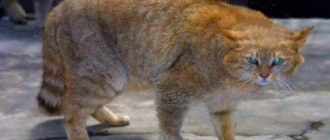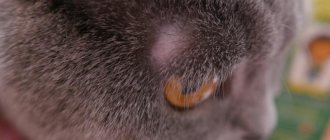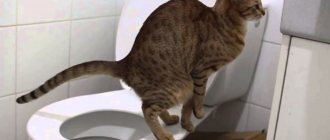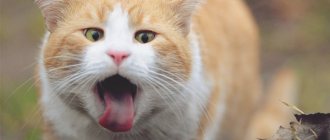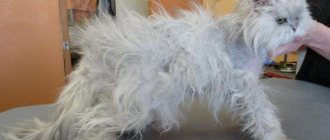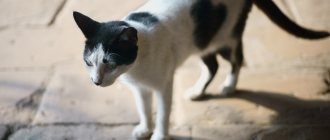12622Administration
1
Cats are very clean animals and licking is a completely normal need. The cat cleanses the fur of dirt and improves its thermoregulatory properties. Every day, furry pets devote a lot of time to fur hygiene, but having noticed that the process of caring for the fur has become intrusive in nature, the cat licks the fur down to the skin, it is very important to establish the root cause. Intense frequent licking is an alarming signal indicating the presence of any pathologies or complications.
The most common places for licking fur to the skin
If you notice that your pet constantly cleans itself with its tongue and the following signs are present, for example, frequent spitting out of hairballs or bald spots on the skin, then you should worry about its health. Excessive cleaning becomes an indicator of problems. This could be sunburn, hypothermia and other external influences. A healthy skin is resistant enough to resist various infections. But if the upper layer of the dermis is damaged, then it becomes easier for viruses and bacteria to enter the body. An infected wound will hurt and itch. Therefore, he will lick this place more often. It turns out to be a vicious circle. You can only help by ridding it of the root cause.
In any case, you need to contact a veterinarian.
Ignoring symptoms will most likely lead to much more serious consequences. Usually owners notice that something is wrong when bald spots appear. Different locations of licking may have different causes. Therefore, take a closer look at your animal's behavior.
The belly came out to the bald spot
Licking to bald spots on stomach
The etiology is:
- Stress. Cats love to get a lot of attention. Owners who took a new tenant into their apartment just for the entertainment of their child often forget about him. Then he becomes lonely and because of this he begins to actively lick himself, which entails baldness.
- Itching. If your pet begins to lick its tummy more and more often, then it is necessary to examine it. If there are no external signs, take him to a veterinarian who will make an accurate diagnosis.
- Parasites. Fleas and lice are the most common diseases in four-legged animals. No need to ignore this. Such “uninvited residents” prevent the cat from living a full life.
Up to the bald spots on the hind legs
A common problem is the appearance of bald spots on both the hind and front legs. Four-legged friends actively use their paws, so if such bald patches have been noticed, then the problem must be addressed urgently. Typically this is due to the filler. The flavoring contained in it causes itching and leads to irritation of the skin.
The cat licked the fur
Near the tail
Has your pet started actively licking its tail or underneath it? You should be careful, perhaps he has acquired unpleasant guests - internal parasites. But sometimes during estrus, blood can get on the tail, causing an unpleasant sensation in the animal.
On the back
It is difficult for them to lick their fur along the spine. If the cat does this often, then take him to a specialist. Such a symptom may indicate serious diseases: pyoderma, notoedrosis and other problems.
Veterinarian advice
Despite the risks of being outside, the cat needs fresh air, so you should not limit its freedom. Since infections and parasites are transmitted through hands or from other animals, preventative treatment against parasites should be carried out regularly.
Veterinarian advice:
- The animal must be kept clean.
- A good immune system will protect your cat from any infection. The key to health is proper and balanced nutrition.
- To prevent allergies, you should not include smoked and salty foods in your diet. Sweets are also prohibited.
- A change of owner or a sharp change in attitude towards a pet leads to stress and illness. A pet needs to be loved, cared for, and given enough attention.
Be sure to read:
Why does a cat shake its ears and head constantly, causes of itching, how to help and what to do
A signal about the development of the disease can be constant licking of fur, scratching and excessive attentiveness to one’s appearance. Often the cat owner thinks that the pet has fleas, but when examining the fur, it is clear that this is not the reason.
Possible causes of itching:
- allergy;
- fungal diseases;
- hormonal diseases;
- hypo- and vitamin deficiencies;
- change of diet.
Sometimes itching occurs for psychogenic reasons. Increased licking and scratching occurs when the animal is stressed. This is often observed when an individual requires mating. Taking sedatives will help calm your pet.
Cats always try to lick wounds, sores and other skin lesions. After sterilization, a seam remains, which itches and itch, so the animal scratches and licks it. To prevent bleeding or other serious complications, a surgical collar is placed on the cat.
It can be difficult to diagnose why an animal constantly licks itself. First, the cat is checked for fleas, then it is analyzed whether the diet or care products have changed.
With a skin disease, the animal often shakes its head and licks itself until it bleeds. Only a doctor can diagnose the disease, so the pet must be taken to the clinic immediately. Based on the scrapings taken, they will be able to identify mites or fungal spores.
Causes
Soreness, itching or active licking often indicates that your pet is sick. The most common cause is fleas. His skin is too sensitive to these parasites. But besides fleas, there are other diseases, to determine which you need to contact a veterinarian.
Allergy
Mostly, allergies occur due to improper feeding. Some types of dry food cannot be completely digested by a small organism. This has a detrimental effect not only on the skin, drying it out and causing inflammation, but also on all organs in general. After all, the tiny amount of digestible nutrients is not enough for them to live a normal life.
This is far from a rare reason, since the unpleasant sensation is a reason to lick the sore spot. For an accurate diagnosis and proper treatment, you should contact a veterinary clinic.
Stress
Animals have quite a lot of situations that cause stress: a new owner, a change of place of residence, an aggressive attitude towards them, a new pet (only in 10% of cases they coexist peacefully), insufficient attention. Therefore, there is no need to ignore the stress factor.
Parasites
Representatives of the cat family can become infected with fleas, lice, lice, and ticks. Because of this, they begin to actively lick the affected area with their tongue. Such residents will annoy him, causing itching and unpleasant sensations. Therefore, he will do his best to rid himself of them.
If these are not external, but internal helminths, such as worms and other worms, then bald spots will be observed in the tail area or under it. During their life, nematodes secrete enzymes that are toxic to the body, which leads to irritation of the anus.
Skin damage
Ordinary scratches and abrasions irritate the animal, creating discomfort and pain. These types of wounds occur outside the home. On the street, a four-legged friend is left to his own devices and can accidentally injure his skin or get injured in a fight with another representative, which will negatively affect his health.
Why does a cat lick its fur more than necessary?
Allergy to food
One reason may be an allergic reaction to food. For example, dry food may contain plants that cats do not naturally eat. Consult with experts and choose food suitable for your cat.
Itching and parasites
The cat licks areas of the body where it is itchy or painful. Licking in the anal area can be caused by constipation. Sick areas are licked more “targeted” than itchy areas. In case of itching, the licking area exceeds the size of the itchy area. The appearance of bald patches provides clues to the cause of excessive licking of fur.
Skin wounds
Cats lick scratches and other skin lesions. This is a normal process that cleanses the wound. In nature, a cat has no other way to take care of itself. However, this may be undesirable when the wound is treated with some kind of ointment or a suture is applied. To prevent unnecessary licking, you should limit your cat's access to the affected area.
Cats really don’t like closed doors, where they used to go freely. The cat is worried, not knowing what is happening in the closed (its!) territory. Additionally, while cats can get by with a small living space, it shouldn't be too small. Perhaps any of us would begin to tear our hair out, being locked in an apartment for years 24 x 7. We consult with family members when making any decisions. And although we cannot consult with a cat, we are quite capable of taking its interests into account.
Excessive licking is not always associated with a cat's physical health. Its cause may also have a psychological basis. Cats like their lives to be predictable and orderly, so unexpected changes can be stressful, says Dr. Perry. Reconstruction of the apartment, the appearance or disappearance of other animals, and sometimes even a change in regime cause anxiety in cats.
It happens that people try to force a cat to live by their own rules and do what they see fit. Such tricks do not work with cats - she is a free animal (conditionally domestic), she cannot be defeated, you can only come to an agreement. It is necessary to take into account her interests, creating as many opportunities for the cat as possible to satisfy her natural needs.
Licking in such cases is considered “replacement behavior” (people in such cases behave similarly, for example, biting their nails) - it calms the cat, but at the same time can become habitual if the source of anxiety is not noticed and eliminated in time.
If all medical problems are resolved, then treatment for excessive licking as a result of some form of stress in the cat's life is necessary, says Dr. Perry. If possible, changes should occur gradually, while maintaining elements of the environment familiar to the cat. For example, when moving, you need to take the cat house with you.
Provide elevated platforms that cats love - they make the cat feel safe and are perceived as possible escape routes. Help your cat show its hunting instincts by playing with it for just 10-15 minutes a day. Most cats love to be played with.
In addition, licking gives cats some pleasure. Thus, excessive licking can become a habit that continues after the cause is identified and addressed. Typically, a cat's fur licking returns to normal (on its own or after assistance) within a month.
With both physiological and mental causes of licking problems, resolving them takes time and patience. With proper attention and care, the cat's fur is restored and life returns to normal.
Treatment
The root cause of a particular disease affects its treatment. But in any case, you should contact your veterinarian for help in diagnosis and treatment. If your friend has a helminthic infestation, the clinic will prescribe anthelmintic drugs. If the disease is caused by an allergy, then the right decision would be to change the food or filler.
Don’t forget to spend time with your pet, so he will feel your love and care. Even if this does not help, you can purchase sedatives in the form of drops at a veterinary pharmacy. They will make your pet feel calmer.
Severe stress
Is overgrooming a sign of illness?
There are many conditions that lead to excessive licking, often due to the resulting itching or soreness of the skin. Probably the most common cause is hypersensitivity to flea bites. Skin irritation in cats can also be the result of a reaction to substances in their diet or environment.
In addition to those listed, there are many other reasons that may require special analyzes and tests to determine.
Prevention
Don't neglect your pet's health. At least once every six months you should take your pet for a full diagnosis.
Stress has a detrimental effect on them. Therefore, try to create comfortable conditions for him and do not neglect sedatives, but only as prescribed by a doctor.
Carry out a visual inspection daily. If he shows signs of illness, he should promptly seek help from specialists.
Stick to a feeding regimen and a properly formulated diet. To do this, you can consult a doctor.
To summarize, we can say that when a cat licks its fur, it does not always indicate the presence of a disease. Clean representatives can lick themselves after being petted. The smell of a person remains on the hands. For their own comfort, they return their smell. In this way, they perceive their surroundings better - smells help them see this world.
What parts of the body are most often affected by overgrooming?
In principle, any areas of skin that the cat can reach with its tongue can be damaged. The most common cases are lesions on the abdomen, the inside of the hind legs, the front legs, and the front and rear sides of the body. The lesions are often located symmetrically on both sides of the cat's body.
Ovegrooming should be distinguished from true alopecia (partial or complete absence of hair in the area of the body where hair usually grows). The difference is that the broken hair remaining after licking feels prickly and sharp to the touch, while with alopecia (baldness) the remaining hair remains soft.
What to do if your cat starts licking herself excessively?
As with other cases of behavioral problems in cats or signs of disease, it is important to consult your veterinarian without delay. The cat needs to be treated for the underlying condition, but what is causing the cat stress, causing or exacerbating the problem may need to be identified and addressed.
There are many reasons for sudden alopecia in cats. It should immediately be noted that the independent appearance of such a symptom is impossible; there is always a reason for this in the form of some kind of pathology.
During seasonal shedding, cats lose hair evenly throughout their entire body.
Baldness in the area of the hind legs most often occurs with liver lesions.
If only one area is balding and there are no visible reasons for this, you should immediately consult a doctor.
for a complete comprehensive examination.
Possible factors causing alopecia:
- damaged hair follicles;
- injuries;
- stress;
- failure of endocrine processes;
Baldness in the abdomen and hind legs most often occurs with liver damage, endocrine diseases and lack of vitamins, although other causes cannot be ruled out.
Avitaminosis
The reasons for the appearance of this pathology are clear from the name itself - a lack of vitamins in the pet’s body.
For normal functioning, the cat's body requires a complex of vitamins.
For normal functioning, the cat’s body, like the human body, requires the entire complex of vitamins
and useful minerals and the lack of them provokes various pathological processes. A lack of vitamins of a certain group is manifested by specific symptoms characteristic of this particular pathology.
Alopecia
A lack of B vitamins in the body can cause periodic vomiting in a cat.
Alopecia is a sign of a lack of B vitamins in the body.
- Along with the main symptom, there is a disorder of the digestive system in the form of periodic vomiting.
- Signs of dysfunction of the nervous and muscular systems appear.
- The animal is weak, lethargic, has an unsteady gait, and a sharp loss of weight.
- Global deficiency of vitamin B1 is expressed by paralysis and convulsions.
- Eliminated by eating more raw meat, bone meal, and yeast.
- Among other things, replenishment is required through the use of special vitamin preparations.
- Deficiency of vitamins B2 and B5 is manifested by cracks in the mucous membranes, slower growth of babies, decreased heart rate and body temperature.
- Eliminated by consuming dairy products and foods of plant origin.
- A lack of vitamin B12 manifests itself in more serious symptoms: urinary disorders, enlarged liver and spleen, and intestinal colic.
Help only under the supervision of a veterinarian.
Cirrhosis of the liver
The disease is very severe, characterized by extensive replacement of liver tissue with connective cells, resulting in gradual destruction of the liver.
Liver cirrhosis in a cat.
As a result, a malfunction occurs, and subsequently a complete failure of all functions of the organ. There are several reasons for the appearance of this pathology.
Primary factors
Primary factors are most often caused by gradual intoxication of the body
and, as a result, a large accumulation of toxins in the liver. Another reason that led to cirrhosis is hypovitaminosis of group B. With this pathology, symptoms appear after some time, as a result of the action of some aggressive factor. Provoking factors are also the failure of metabolic processes and hereditary predisposition.
Lack of food containing B vitamins can lead to cirrhosis of the liver.
Secondary factors
Invasive diseases and pathologies of the cardiovascular system act as secondary aggressors.
Infectious diseases can cause cirrhosis.
Signs
- For a long time, the only sign of cirrhosis may be baldness of the pet in the abdomen and hind legs
. - Further, as the disease progresses, the abdomen becomes enlarged
, which may indicate ascites. - , apathy and aggressive reactions to any attempts at contact are manifested.
- , weight loss, with strong thirst.
- Frequent urination.
- In the final stages , loss of coordination and decreased vision
.
An enlarged abdomen may indicate ascites.
Treatment and therapy
No therapy will give a restorative result.
Treatment is aimed at maintaining the heart and stopping the progression of the disease. If you refuse to eat, force-feeding is used using a drip infusion of glucose solution. Vitamin therapy and diuretics are prescribed.
If you refuse to eat, feeding with a drip solution is used.
Endocrine focal symmetric alopecia
The nature of this disease is a hormonal imbalance in the animal’s body.
Like most pathologies, it cannot arise independently and there are quite a lot of provoking factors: hypothyroidism, hyperfunction of the thyroid gland, hyperfunction of the adrenal cortex, diabetes. As a rule, symmetrical baldness is not accompanied by itching
, although in the presence of allergic reactions a similar phenomenon is quite possible, but in very rare cases.
As a rule, baldness is not accompanied by itching.
Treatment
Treatment depends on the identified pathology and is applied strictly under the supervision of a veterinarian. The owner’s only comprehensive help is timely contact with a specialist.
Treatment should be strictly under the supervision of a veterinarian.



